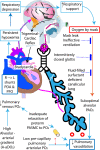Hemodynamic consequences of respiratory interventions in preterm infants
- PMID: 35690691
- PMCID: PMC9436777
- DOI: 10.1038/s41372-022-01422-5
Hemodynamic consequences of respiratory interventions in preterm infants
Erratum in
-
Correction to: Hemodynamic consequences of respiratory interventions in preterm infants.J Perinatol. 2022 Aug;42(8):1147-1148. doi: 10.1038/s41372-022-01453-y. J Perinatol. 2022. PMID: 35790853 Free PMC article. No abstract available.
Abstract
Advances in perinatal management have led to improvements in survival rates for premature infants. It is known that the transitional period soon after birth, and the subsequent weeks, remain periods of rapid circulatory changes. Preterm infants, especially those born at the limits of viability, are susceptible to hemodynamic effects of routine respiratory care practices. In particular, the immature myocardium and cardiovascular system is developmentally vulnerable. Standard of care (but essential) respiratory interventions, administered as part of neonatal care, may negatively impact heart function and/or pulmonary or systemic hemodynamics. The available evidence regarding the hemodynamic impact of these respiratory practices is not well elucidated. Enhanced diagnostic precision and therapeutic judiciousness are warranted. In this narrative, we outline (1) the vulnerability of preterm infants to hemodynamic disturbances (2) the hemodynamic effects of common respiratory practices; including positive pressure ventilation and surfactant therapy, and (3) identify tools to assess cardiopulmonary interactions and guide management.
© 2022. The Author(s).
Conflict of interest statement
The authors declare no competing interests.
Figures



References
-
- Prsa M, Sun L, van Amerom J, Yoo SJ, Grosse-Wortmann L, Jaeggi E, et al. Reference ranges of blood flow in the major vessels of the normal human fetal circulation at term by phase-contrast magnetic resonance imaging. Circ Cardiovasc Imaging. 2014;7:663–70. doi: 10.1161/CIRCIMAGING.113.001859. - DOI - PubMed

